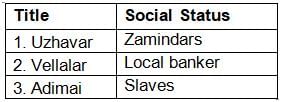Practice Test: Ancient India- 1 - Delhi Police Constable MCQ
30 Questions MCQ Test - Practice Test: Ancient India- 1
Consider the following statements with reference to why hunters-gatherers moved from place to place in ancient times.
1. Fear of eating up all the available plant and animal resources if stayed at one place.
2. Because animals to be hunted move from place to place.
3. Plants and trees bear fruit in different seasons.
Which of the above statement(s) is/are correct?
With reference to Chalcolithic cultures in the Indian subcontinent, consider the following statements:
1. Ochre-coloured pottery sites have been usually found in the Gangetic doab of India.
2. Anthropomorphic figures of worship have been found in the copper hoard culture.
Which of the above is/are correct?
Consider the following statements:
Assertion (A): In the ancient period of Indian history, urbanisation was followed by pastoral life.
Reason (R): The Harappan culture was an urban one.
Choose the answer using the code given below:
Which of these statements is not correct about the Indus Valley Civilisation?
1. People worshipped the Mother Goddess or Goddess of fertility.
2. Dancing was a part of the culture at Indus valley.
3. The trade and cultural contacts were restricted to the other cultures in the Indus valley.
Choose the correct answer using the codes below.
Consider the following statements:
1. In the early-Harappan stage, the people lived in large villages in the plains.
2. In the late-Harappan stage, the Indus culture rose to its peak and started spreading Southern India and across Indian frontiers.
Which of the above is/are correct?
If you were living in the Harappan civilisation, you might have come across which of the following specialised groups of artisans?
1. Goldsmiths
2. Stonecutters
3. Weavers
Select the correct answer using the codes below.
During the Rig Vedic period, Bharatas, Matsyas, Yadus and Purus refer to
In the Early Vedic period, who was known as Vishayapati?
Consider the following statements regarding Rig Vedic Aryans.
1. There are no evidence of the use of Iron by Rig Vedic Aryans.
2. Trade was conducted on the barter system.
3. Copper coins called nishka were used as media of exchange in large transactions.
Which of the above statements is/are incorrect?
Which of the following statement is incorrect about Nalanda University?
Mahayana refers to one of three routes to enlightenment. What are the other two?
Consider the following statements;
1. In Mahayana and Vajrayana Buddhism, she is a deva or Bodhisattva associated with the light and the sun.
2. She had been depicted with one, three, five or six faces. In her many-faced manifestations, one of her faces is that of a sow.
To which goddess does above description refer to?
Consider the following famous Chinese Buddhist Pilgrims;
1. Faxian
2. I-Qing
3. Xuan Zang
Arrange them chronologically as per their visit to the Indian subcontinent;
The doctrine of Anatta in Buddhism means that
1. There is no permanent and independent essence in a human being.
2. The sense of self as perceived by beings is illusionary.
Which of the above statement is/are correct?
In the apsidal end of the Vishwakarma chaitya hall is a stupa on the face of which a colossal 3.30 metres seated Buddha in Vyakhyana mudra (Teaching posture) is carved.
Above mentioned statue of Buddha is found in which of the following places in India?
Nyngma, Kagyud, Shakya and Geluk are sects/schools of
Which of these sutras is not related to Buddhism?
The conversation between Nagasena and Menander-I related to Buddhism is recorded in which book?
Consider the following statements: Andal was a woman Alvar whose compositions were widely sung. Karaikkal Ammaiyar was a devotee of Shiva who adopted the path of extreme asceticism in order to attain her goal.
Q. Which of the above statements is/are correct?
Which of these is not one of the so called ‘Five Epics’(the five great poems) attributed to the Sangam age?
Consider the following pairs;

Which of the above is/are correct?
Ancient Indian thinkers had arrived at an elaborate system of ideas on motion. It was in a way similar to the laws of the motion. In these Indian systems, which of the following concepts comes closest to the concept of inertia?
Which of the following propositions have been given by the Vaisheshika Darshana?
1. Dharma is that through which there is the accomplishment of rising to the unsurpassed good.
2. The true being is eternal, having no cause.
3. Dharma does not have the authority of Vedas as its surpassed Vedas.
Select the correct answer using the code given below;
Consider the following statements with reference to ‘Romas’ group of people;
1. Were Indians who went abroad as wanderers.
2. Are known as Gypsies in Europe
3. Settled as a group mainly in Pakistan and Afghanistan
Which of the above statement is/are correct?
Who is regarded as the greatest lawgiver of ancient India?














